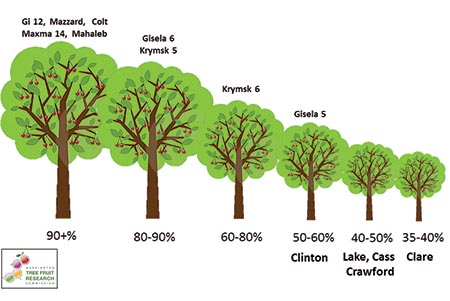All commercial cherry trees are made up of two parts: the upper fruiting portion (grafted or budded scion wood); and the lower portion ( the rootstock). Until fairly recently, the majority of breeding efforts were directed towards fruit improvement. Over the past century, breeding programs have concentrated mainly on achieving improved characteristics such as yield, taste, fruit size, fruit firmness, fruit color, precocity, and resistance to fruit cracking and disease. In contrast, rootstock development has only recently received breeders attention. It is believed that ‘Mazzard’ seedlings are the oldest known sweet cherry rootstock dating back to the early Greeks and Romans. And this is still the most widely used rootstock for sweet cherry throughout the Pacific Northwest. Many of the newer rootstocks are described using Mazzard as a standard for comparison. Recently, several new rootstocks have gained prominence for their improved attributes. Many of these are semi-dwarfing. Some of these may impart some disease resistance, induce precocity (bearing younger, and lend themselves to use in high-density plantings. There is an excellent PNW Extension publication by L. Long and C. Kaiser reviewing the performance of the major sweet cherry rootstocks grown around the region. (download pdf PNW619) Listed below are many of the sweet cherry rootstocks available for use in the Pacific Northwest.

- Relative size comparison chart of several rootstocks being evaluated by Michigan State University and Washington State University. More information about this graphic can be found in this Good Fruit Grower article.
Listed below are many of the sweet cherry rootstocks available for use in the Pacific Northwest. Click on the heading to view details about each rootstock.
Mazzard (P. avium)
A fibrous root system makes Mazzard a good choice for wet and heavy soils. Mazzard is the most popular cherry rootstock grown in North America. It is generally more vigorous than Mahaleb, especially in poorer soils.
Mahaleb
Performs in deep soils with good drainage. This rootstock is somewhat dwarfing, cold hardy and precocious. Deep rooted. Not recommended for heavy soils or areas with high water tables.
Gisela® 5 (148-2 cv.) USPP #9622
A popular introduction in Germany, this rootstock produces a very precocious tree approximately half the size of trees grown on Mazzard rootstock. It produces an open, spreading tree with wide angles. It is quite virus tolerant and does well in heavy soil. Trees grown on Gisela® 5 may need to be supported. Some suckering may occur depending on growing conditions. It is very hardy and produces well. It is compatible with most varieties. It has shown good results in Washington State.
Gisela® 6 (148-1 cv.) USPP #8954
A semi-dwarf rootstock that produces a tree slightly smaller than Mazzard, roughly 80 to 90 percent. A good substitute for Mazzard, Gisela® 6 is well suited for heavy soil types. The tree structure is very open and round. Very precocious despite its vigor. It appears tolerant to many cherry viruses and is not prone to suckering. Anchors well, but may need support, especially in the first fruiting years because of its precocious nature.
Gisela® 12 (195-2 cv.) USPP #9631
A precocious, semi-dwarf cherry rootstock, yielding a tree about 60% of one grown on Mazzard. Produces a tree that is spreading and open. Resists suckering, is well anchored but may require support.
Colt
Good anchorage and vigor. Heavier soils okay. Clay loam. Very vigorous, smaller than Mazzard. NOT COLD HARDY.
Krymsk® 5 (USSP #15,723)
Reduces tree size by 20% to 30% compared to those grown on Mazzard. Non-suckering trees. The rootstock is precocious and compatible with all cherries. Sensitive to Prunus ringspot & Prunus dwarf virus.
Krymsk® 6 (USPP #16,114)
Reduces tree size by 20% to 30% compared to those grown on Mazzard. Tolerant to water stress and easy to propagate by softwood cuttings. Sensitive to Prunus ringspot & Prunus dwarf virus.

